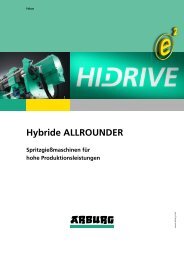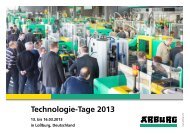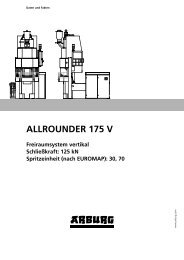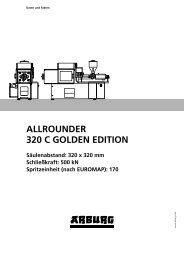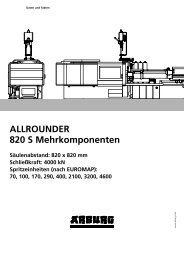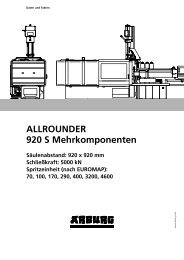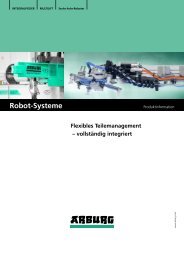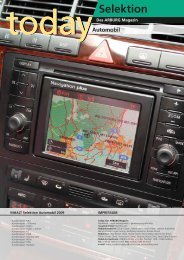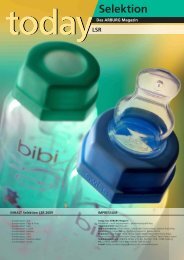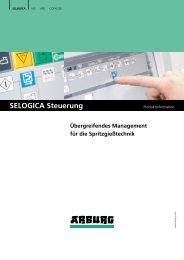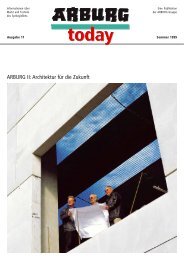The ARBURG Magazine - British Plastics & Rubber
The ARBURG Magazine - British Plastics & Rubber
The ARBURG Magazine - British Plastics & Rubber
You also want an ePaper? Increase the reach of your titles
YUMPU automatically turns print PDFs into web optimized ePapers that Google loves.
cars, the future’s<br />
blue<br />
<strong>The</strong> Fuchs camera system consists of<br />
four cameras, and monitors the presence<br />
and position of the contacts, checks for<br />
burrs on the connector shroud and monitors<br />
the presence and position of the<br />
locking hook, which secures the two<br />
parts. If the moulded parts are recognised<br />
as “OK”, the good parts are marked<br />
and deposited in blister packs on a<br />
Schuma palletising system. <strong>The</strong> latter features<br />
a feed and exit section as a buffer,<br />
and can therefore work self-sufficiently<br />
for eight to ten hours.<br />
<strong>The</strong> two-cavity mould with a second,<br />
separate lower section for dual-station<br />
production works with sensor scanning,<br />
to ensure perfect monitoring of the presence<br />
and position of the contacts. This<br />
ensures that there are no downtimes during<br />
production.<br />
Wolfgang Ebner, Managing Director at<br />
MKT, is delighted with the production<br />
cell: “This complex, automated system<br />
was the first production unit that we installed<br />
and started up in our new<br />
2,250-square-metre company building,<br />
which we acquired at the end of 2008.<br />
<strong>The</strong> system works without problem,<br />
enabling us to be a reliable supplier of<br />
this promising technology for Mercedes-<br />
Benz.”<br />
<strong>The</strong> BLUETEC pollutant reducing system<br />
is the diesel vehicle’s closest equivalent<br />
to the catalytic converter for petrol<br />
engines. Mercedes Benz Cars developed<br />
this filter technology exclusively for<br />
Mercedes-Benz vehicles. BLUETEC is al-<br />
ready used with great success in cars for<br />
the US market, but also in Germany, the<br />
first mass-production vehicles with<br />
BLUETEC have already taken to the<br />
road.<br />
This technology incorporates several<br />
different pollutant-reducing variants<br />
which, besides reducing hydrocarbons,<br />
carbon monoxide and particulates, are also<br />
intended to break down nitrogen<br />
oxides. <strong>The</strong> components produced by<br />
MKT are employed in the SCR<br />
(Selective Catalytic Reduction)<br />
process for a urea sensor that<br />
ensures precisely the correct<br />
dosage of the aqueous AdBlue<br />
urea solution, which is<br />
contained in an additional<br />
tank in the vehicle.<br />
AdBlue is converted into ammonia in<br />
the exhaust pipe. In the downstream SCR<br />
catalytic converter, the ammonia changes<br />
the nitrogen oxides into harmless nitrogen<br />
and water. In this way, up to<br />
80 % of nitrogen oxides in diesel vehicles<br />
can be filtered. This is an extremely interesting<br />
technology, which owes its perfect<br />
function not least to the high precision<br />
of ALLROUNDER injection moulding<br />
machines.<br />
MKT has known for a long time that<br />
it can trust in the reliability of <strong>ARBURG</strong><br />
technology. <strong>The</strong> company was founded<br />
from the Wehrle company following a<br />
management buyout in 1996 and had already<br />
worked with ALLROUNDERs before.<br />
Today, the German plants of MKT<br />
today 40/2009<br />
17<br />
PROJECT<br />
Housing and cover for the control unit of the<br />
BLUETEC urea sensor (below). Project managers<br />
at MKT: Hans-Joachim Dietsche, Injection<br />
Moulding Manager, Wolfgang Ebner,<br />
Managing Director and Edgar Blatter, Mould<br />
Construction Manager (left, from left to right).<br />
Metall- und Kunststofftechnik GmbH are<br />
principally occupied with the production<br />
of housings for electronic assemblies for<br />
the automotive industry, metal-plastic<br />
bonds and moulded parts from two components.<br />
70 % of production is dedicated<br />
to the automotive sector, but customers<br />
also include office furniture and the<br />
aviation industry, supplying guides or inserts<br />
for tables on aeroplanes, for example.<br />
Engineering plastics such as PA 6, PA<br />
66, PBT, TPU, TPE and POM are predominantly<br />
used for processing. Here is what<br />
Hans-Joachim Dietsche, Injection Mould-



